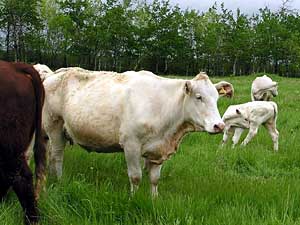|
Photos
More from MPR
|
July 27, 2005
 |
| Cattle from Canadian herds are once again being shipped to the U.S. (MPR Photo/Bob Reha) |
Some fear opening the border increases the risk of spreading mad cow disease in the U.S. But it appears those concerns aren't making much of an impression on some consumers.
Moorhead, Minn. — Mad cow disease is the common name for bovine spongiform encephalopathy, or BSE. It's a fatal brain-wasting disease in cattle. In Great Britain, a human form of that disease killed 150 people in the 1980s and 1990s.
Brian Musolf, manager of the meat department at a Moorhead grocery store, says his customers are more concerned about price than mad cow disease.
He says the store keeps detailed records of where the meat they sell was raised and slaughtered.
"With this Canadian border opening back up, I think there will be a lot more tracking," says Musolf. "The USDA will be taking extra steps to know where everything is coming from, where it's going and what's going on with it."
Safe food is a concern for retired veterinarian Greg Peterson. He spent 25 years with the Food Safety and Inspection Service and says mad cow disease is a real threat.
"You have to put it into context. It's killed a 150 people in the whole world, period," says Peterson. "That's very serious for those 150 people, but still, there's a lot of things worse than that out there."
Peterson says the public perception of mad cow disease is much scarier than it deserves. He believes there are more common threats to people, like salmonella or the E. coli bacteria. Peterson is confident the U.S. Agriculture Department is doing its best to protect consumers from mad cow disease.
"The USDA is already taking out all of the parts of the carcass that would have infected material in it," says Peterson. "Which is primarily the central nervous system, the spinal cord, this sort of thing, and that pretty well does it."
The threat of mad cow disease hasn't prompted any changes in Peterson's eating habits or where he buys food.
Rochelle Wolf shares his opinion. The mother of two believes the threat of mad cow disease has been hyped by the media. She says President Bush has a better chance of finding Osama bin Laden than she has of getting mad cow disease.
Wolf says she believes if she follows the safeguards recommended by the USDA, she and her family will be fine.
"I look for meat that looks fresh and smells right, and I cook it. If it's chicken or pork I make sure it's cooked thoroughly," says Wolf. "I have a steak once in a while, and I like it rare and I just kind of take my chances."
But some people think that's a dangerous approach. Ray Howe is concerned about more than just BSE. Howe describes himself as a working man from Red Wing, Minnesota. He recently toured packing plants in Wisconsin and Minnesota.
Howe says based on what he saw at the two plants, he's lost all confidence in the government's inspection system. According to the Center for Food Safety in Washington D.C., federal agencies relaxed standards for meat inspection in 1998.
"It was just a few years ago that they gave the meatpackers a pass to include more fecal matter in luncheon meat," says Howe. "Their solution to the consumers' concerns about fecal contaminated luncheon meat was, well cook it first."
Howe refuses to buy meat at local stores. He gets his beef from local farmers. He believes that's a trend that will be more common in the coming years. He says as more people learn about how their food is processed in the U.S. they'll be scared into finding a direct source of meat and other food products.






